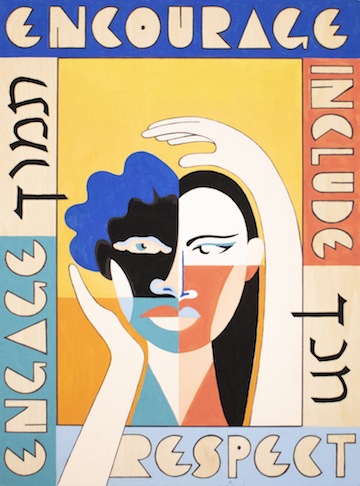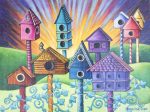“Open Doors” by Marcie Levitt-Cooper.
(photo by Daniel Wajsman)
The group show Community Longing and Belonging, which opened Jan. 15 at the Zack Gallery, marks Jewish Disability Awareness and Inclusion Month (JDAIM).
“I heard about community art shows in celebration of JDAIM in other communities,” said Leamore Cohen, inclusion services coordinator at the Jewish Community Centre of Greater Vancouver, who was the driving force behind the local exhibit.
“I thought an unjuried exhibit would be a fabulous way to honour our community-wide commitment to remove barriers, to celebrate our community members’ creative capacities,” she said.
The main idea was to open up participation to everyone – professional artists and amateurs, people of different skill levels, abilities, perspectives, faiths and socioeconomic status.
“To make participation truly inclusive,” said Cohen, “we provided each artist with a 12-by-16 wood panel. We have also been taking direction from Kickstart Disability Arts and Culture and its artistic director, Yuri Arajs, as we wanted to ensure that this event is fully accessible.”
The JDAIM inclusion initiative and month of advocacy began throughout North America in 2009, explained Cohen. The idea for the art exhibit started to take form last spring, when Cohen approached Zack Gallery director Linda Lando.
“Linda was really receptive to the idea of the show.… Once I had the green light from her, the support and use of the gallery,” said Cohen, “I began to focus more on the theme.”
The theme of community and inclusion prompted her next steps. She reached out to many different organizations and communities and invited artists from all over the Lower Mainland to participate. The call for submissions went out in late September, and the response was remarkable. Fifty-two artists are included in the show.
“We have artists from Vancouver, Burnaby, Richmond, North Vancouver, and even as far out as Cloverdale,” said Cohen. “I’ve had the good fortune to meet all these new and amazingly creative people, welcome them to our community centre, and make new friends along the way. It’s been a joy. It broke my heart that I had to turn many away because of the limited space in the gallery. I have artists who want to sign up for the next year. There is so much excitement and so much more to say on this issue.”

To frame this exhibit, Cohen posed two questions, which are being used in its promotional materials: “How do we make meaning of the concept of community, the real and the imagined spaces we inhabit? What does community longing look like and what are the possibilities for belonging in an ever-changing world?”
“This show was a challenge and an invitation to look at social problems creatively and critically,” Cohen told the Independent. “It was also an opportunity for artists living with diverse needs to exhibit their work in a professional venue and to receive exposure.
“I don’t think we are going to resolve the problems of longing and belonging, or longing for belonging, any time soon. I think we’ll always have people who are better situated and people whose social networks are more tenuous. We should just keep having the conversations and build up those connections. We create new platforms and new access points, new opportunities for people to engage and tell their stories, whatever they look like and from whatever lens, whether it be through mental health, sexual identity, ability or socioeconomic status. We all have a story to tell.”
Cohen shared one example of how the show’s theme relates to her own life.
“The ‘longing’ part of the theme resonates with a lot of people,” she said. “It resonates with me as well. It emerges from my own story of disconnection from the Jewish community during my youth and young adulthood. Fortunately, so, too, does the ‘belonging’ part of this show. The JCC is a wonderful place, a place for belonging.”

The theme allowed for a number of different approaches, and the skill of the various participating artists varies widely, but the utter diversity becomes its main attraction. Although the size and shape of the canvases – the wooden boards provided by the organizers – are universal, the content is anything but, and so is the media. Some pieces are oils, others acrylic; still others, mixed media. There are abstracts and figurative compositions. Some have narratives. Others evoke emotions. Some have Jewish connotations. Others don’t. Some artists participated solo, while others enrolled as a family group.
Marcie Levitt-Cooper represents one such family. Her painting “Open Doors” depicts a colony of colourful birdhouses. Every door of every birdhouse is open, creating a welcoming avian village, a festive metaphor that makes you smile. No birds appear in the image, but you can almost hear them sing. The artist’s three daughters – Rebecca Wosk, Teddie Wosk and Margaux Wosk – also exhibit in the show.
Another family of artists is mother Elizabeth Snigurowicz and son Matthew Tom Wing. “They regularly come to the Jewish Community Centre inclusion services Art Hive drop-in program, a low-barrier, free art program,” said Cohen.
Daniel Malenica doesn’t have a family in the show, but her charming, pastel-toned piece is a jubilation of the artist’s Croatian roots and her LGBTQ+ community. Two girls embrace each other in the painting, both wear Slavic costumes. The title, “Veselye u Selu,” is the English phonetic spelling of a phrase in the artist’s mother tongue, meaning “Celebration at the Village.”
In Evelyn Fichmann’s painting “Embrace,” the artist, a recent immigrant from Brazil, has incorporated words in English and Hebrew. “Encourage,” “include,” “educate,” “respect,” “engage” and “support” surround the image, all fitting descriptors of what we should strive to do in our communities.
Community Longing and Belonging runs until Jan 27.
Olga Livshin is a Vancouver freelance writer. She can be reached at [email protected].

